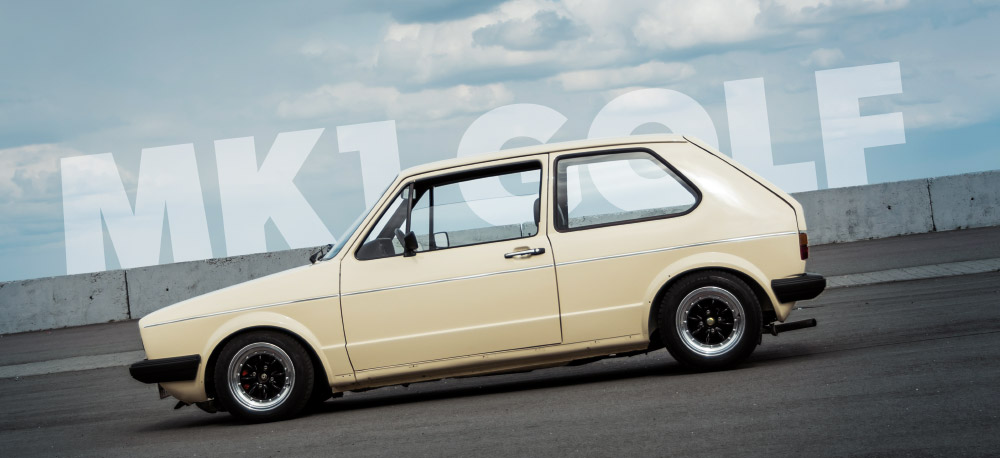Depending on which version of the legend you believe, the Mk1 golf was named after the german word for the gulf stream current, golfstrom.
Given that Volkswagen Group had form at the time for naming its cars after wind systems – Sirocco (Mediterranean wind), Passat
(trade wind) and Jetta (jet stream) – the wind naming theory seems the most credible.
It’s certainly the most apt. For when the Mk1 blew into the market in 1974 it definitely put the wind up the opposition, taking on and surpassing popular models of the time such
as the Allegro, Cortina and Escort. Within a year, it was the 14th best-selling car in
Britain and runner–up in the 1975 European Car of the Year.
However, the best was yet to come. Away from the official factory endorsed programme that unleashed the Mk1 Golf, an unofficial sport version was being secretly developed. The Mk1’s sporty little brother, the GTI, was conceptualised and built by a Volkswagen
elite team of engineering, suspension, chassis and marketing experts, who combined to produce a car that secured legendary status
as the leader of the ‘hot hatch’ pack.
As our guest contributor Richard says of his own pride and joy, a red Mk1 Golf GTI,
“It’s a car that when you park up or take it to an event or show, it always attracts attention. People instantly recognise it and they love it.”
Indeed, that love shown by a generation of car enthusiasts has helped to establish the GTI’s place in the petrol head pantheon of all-time classics. Even when first launched, it achieved almost instant popularity and in 1981, the GTI’s status was truly established when it was voted ‘Car of the Year’ by What Car magazine.
So what makes this heroic little hatch such a group icon? Its origins are to be found in Volkswagen Group’s need to find a successor to its popular Beetle back in the 1970s.
Whose sales had dwindled due to a
maelstrom of market pressures.
Recruiting renowned car designer Giorgetto Giugiaro to design the Golf – he would later come to consider the Mk1 Golf as the most important design of his career – it reflected his signature ‘folded-paper’ style, emphasising sharp corners and flat planes.
It’s most notable engineering feature was to signal Volkswagen Group’s shift from rear-wheel drive and rear-mounted, air-cooled engines to front-wheel drive and front-mounted, water-cooled engines -
often transversely-mounted.
Other key features included two transmission options, a four-speed manual and a three-speed automatic. A five-speed manual became available in 1979.
For the younger, faster GTI, the power
outputs were cranked up to 110bhp,
providing the base speed for tuners and modifiers everywhere to realise their boy/girl racer dreams. It had better suspension, finessed design flourishes, such as the golf ball gear stick and iconic tartan upholstery, and a general styling that inspired many imitators
but was never bettered.
From an initial production run of 5,000 units, the Golf GTI reached the heights of 462,000 units. Since its 1974 launch, the Volkswagen Golf in all its forms and ideations has achieved over 30 million global sales – making it one of the most successful vehicles in Volkswagen Group’s history.
Now into its seventh generation, the Golf is
an iconic trailblazer that defines the term,
‘hot hatch’. Its enduring appeal is best summarised by Richard: “What I love about it most of all is that whenever I drive the car,
it puts a smile on my face.”
That sense of pleasure it brings perfectly captures the appeal of the little hot hatch.
So aptly named after a wind system, it’s blown away generations of fans such as Richard and it seems likely to continue whipping up a motoring storm for many more years.
Richard Farrington, Parts Sales Executive at TPS Bournemouth,
is our next contributor to choose a Volkswagen Group Icon. Richard has selected the Mk1 Golf – the original ‘hot hatch’ hero that helped define a car class that continues to resonate to this day.
INTERIOR
For the GTI, a range of features that included the golf ball gear stick, tartan upholstery, chin spoiler and branded steering rack, helped to make it stand out amongst the hot hatch crowd.
ENGINE
Later Mk1 GTIs had enlarged 1.8 litre engines (and five-speed gearboxes) which delivered more power than the original versions and helped them to
an impressive, 0-60mph of eight seconds.
FROM REAR TO FRONT WHEEL DRIVE
The car’s water cooled, inline four cylinder, four-stroke engine was mounted transversely in the front, and drove the front wheels. It marked a significant shift from rear wheel drive in Volkswagen Group’s major car lines.
WEIGHT
At 840kg, the Mk1 Golf GTI is 14kg lighter than the most featherweight modern-day VW – the Up! – and near enough half the weight of a Mk7.5 GTI.
BODY
Early versions featured a lower horizontal bodyline running under the tail lamps on the rear hatch - dubbed the ‘Swallowtail’ by Golf enthusiasts. A minor design revision saw the Swallowtail deleted in later models, leaving the surviving Swallowtail versions as much sought after.
CHASSIS
The Golf adopted an efficient ‘two-box’ layout with a steep hatchback rather than a formal trunk. The chassis was a steel unibody.
GTI Approved accessories available from your local TPS Centre.
To find out what makes a hot hatch hero click here.




